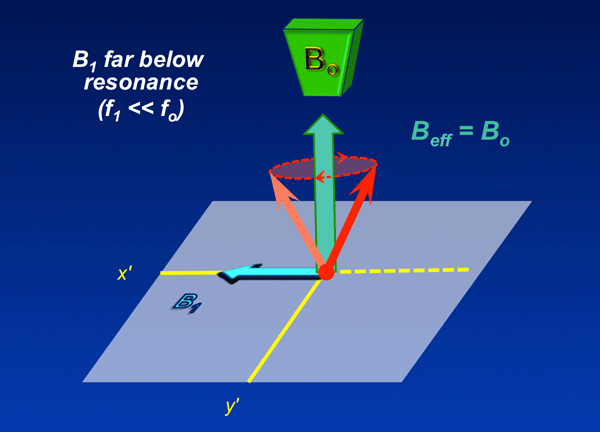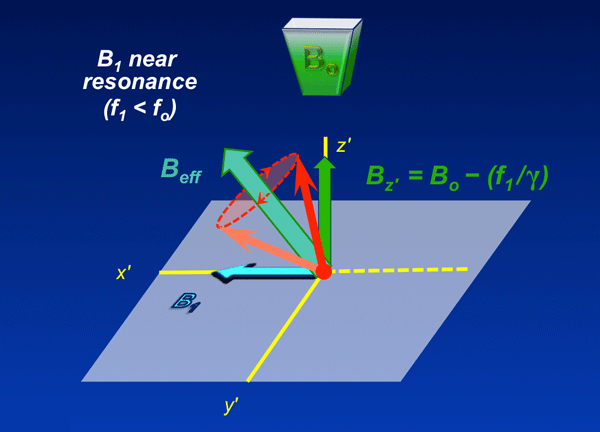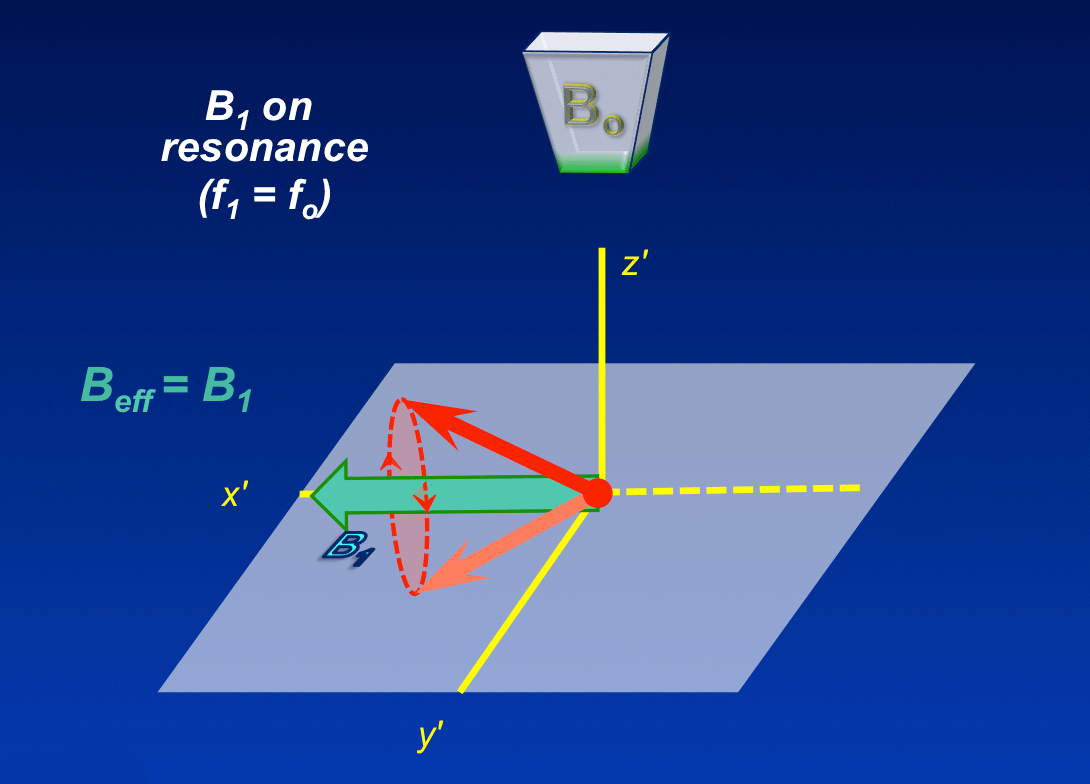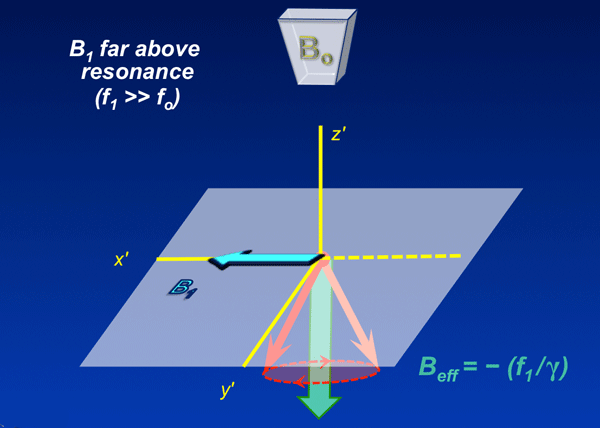Adiabatic excitation is a special type of RF-stimulation that occurs only under certain limited conditions and produces a somewhat surprising motion of the net magnetization (M). A basic phenomenon perhaps more familiar to chemists than to imagers, adiabatic excitation nevertheless does have several practical MRI applications. Modern clinical imaging examples includes its use in spectral inversion pulses (SPAIR), arterial spin labeling (ASL), and for low-noise sequences (SWIFT/SilentScan).
To understand the adiabatic phenomenon, two pre-requisites are necessary. First, you must be familiar with material from two prior Q&A's: 1) the rotating frame concept, and 2) off-resonance effects. You can click on each of these if you need a review.
An additional required concept (presented here for the first time) is of continuous wave (CW) excitation. Continuous wave NMR is an "ancient" technique. The CW method was employed by Bloch and Purcell in their landmark papers on nuclear induction and used routinely in laboratories between the 1940s and 1960s until it was largely supplanted by pulsed NMR techniques.
CW NMR begins like any other experiment: a sample is placed in a static magnetic field (Bo) and its spins start to precess at the resonant frequency (fo). A transverse RF field (B1) is then applied in a very gradual fashion. During this process the magnitude of B1 is held constant, but its frequency (f1) is gradually increased from below resonance (f1<fo), to resonance (f1=fo), and beyond resonance (f1>fo).
As discussed in the rotating frame Q&A, if the RF-field (B1) is not applied exactly on resonance, the magnetization M will precess around the direction of an effective field Beff that oriented at an angle to both Bo or B1. Provided the B1 field is strong enough and applied slowly enough (the adiabatic condition) M will gradually follow Beff during the B1 frequency sweep. This is known as adiabatic following.
To understand the adiabatic phenomenon, two pre-requisites are necessary. First, you must be familiar with material from two prior Q&A's: 1) the rotating frame concept, and 2) off-resonance effects. You can click on each of these if you need a review.
An additional required concept (presented here for the first time) is of continuous wave (CW) excitation. Continuous wave NMR is an "ancient" technique. The CW method was employed by Bloch and Purcell in their landmark papers on nuclear induction and used routinely in laboratories between the 1940s and 1960s until it was largely supplanted by pulsed NMR techniques.
CW NMR begins like any other experiment: a sample is placed in a static magnetic field (Bo) and its spins start to precess at the resonant frequency (fo). A transverse RF field (B1) is then applied in a very gradual fashion. During this process the magnitude of B1 is held constant, but its frequency (f1) is gradually increased from below resonance (f1<fo), to resonance (f1=fo), and beyond resonance (f1>fo).
As discussed in the rotating frame Q&A, if the RF-field (B1) is not applied exactly on resonance, the magnetization M will precess around the direction of an effective field Beff that oriented at an angle to both Bo or B1. Provided the B1 field is strong enough and applied slowly enough (the adiabatic condition) M will gradually follow Beff during the B1 frequency sweep. This is known as adiabatic following.
In the final stage of this process (when B1 has been swept to a frequency far above resonance) note that M has been inverted a full 180°. This is known as adiabatic inversion. Pulses creating these adiabatic changes in M are considered in the Advanced Discussion Section below.
Advanced Discussion (show/hide)»
The adiabatic condition is formally expressed by |dθ/dt| << γ |Beff|, where θ = arctan {B1(t)/Bz'(t)} = the angle made by Beff with the y'-z' plane. This is often rearranged into an adiabatic factor η is defined as η = γ |Beff| /|dθ/dt|.
Thus to satisfy the adiabatic condition requires η to be sufficiently larger than unity. Whenever this condition is satisfied, a magnetization that is initially collinear with Beff will remain collinear with Beff. Additionally, a magnetization that is initially perpendicular to Beff will precess around Beff in a plane perpendicular to Beff while the pulse is being applied.
Click on the button to go to a secret Q&A page that discusses adiabatic pulses!
References
De Graaf RA, Nicolay K. Adiabatic rf pulses: applications to in vivo NMR. Concepts Magn Reson 1997; 9:247-268.
Norris DG. Adiabatic radio frequency pulse forms in biomedical nuclear magnetic resonance. Concepts Magn Reson 2002; 14:89-101.
Redfield AG. Nuclear magnetic resonance saturation and rotary saturation in solids. Phys Rev 1955; 98:1787-1809. (This paper, considered one of the most important in early NMR, showed that the Bloch equations, though accurate in liquids, violated the Second Law of Thermodynamics in solids. Redfield expands upon the rotating frame concept here leading to a better understanding of spin ordering, spin locking, and adiabatic phenomena.)
Tannus A, Garwood M. Adiabatic pulses. NMR in Biomed 1997;10:423-434
Ulmer JL, Mathews VP, Hamilton CA, Elster AD, Moran PR. Magnetization transfer or spin-lock? An investigation of off-resonance saturation pulse imaging with varying frequency offsets. AJNR Am J Neuroradiol 1996; 17:805-819. (See Appendix for a simplified discussion of rotating frame and spin-locking.)
De Graaf RA, Nicolay K. Adiabatic rf pulses: applications to in vivo NMR. Concepts Magn Reson 1997; 9:247-268.
Norris DG. Adiabatic radio frequency pulse forms in biomedical nuclear magnetic resonance. Concepts Magn Reson 2002; 14:89-101.
Redfield AG. Nuclear magnetic resonance saturation and rotary saturation in solids. Phys Rev 1955; 98:1787-1809. (This paper, considered one of the most important in early NMR, showed that the Bloch equations, though accurate in liquids, violated the Second Law of Thermodynamics in solids. Redfield expands upon the rotating frame concept here leading to a better understanding of spin ordering, spin locking, and adiabatic phenomena.)
Tannus A, Garwood M. Adiabatic pulses. NMR in Biomed 1997;10:423-434
Ulmer JL, Mathews VP, Hamilton CA, Elster AD, Moran PR. Magnetization transfer or spin-lock? An investigation of off-resonance saturation pulse imaging with varying frequency offsets. AJNR Am J Neuroradiol 1996; 17:805-819. (See Appendix for a simplified discussion of rotating frame and spin-locking.)
Related Questions
What is the rotating frame of reference?
How does an adiabatic pulse differ from a regular RF-pulse? What is it used for?
What is the rotating frame of reference?
How does an adiabatic pulse differ from a regular RF-pulse? What is it used for?
|
© 2024 AD Elster, ELSTER LLC
All rights reserved. |
|




